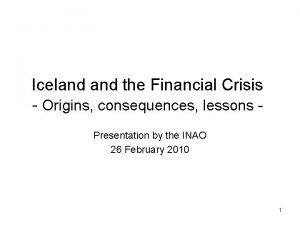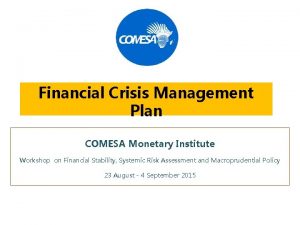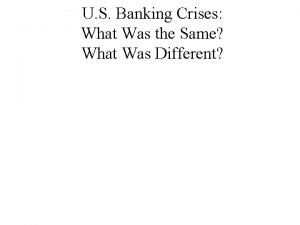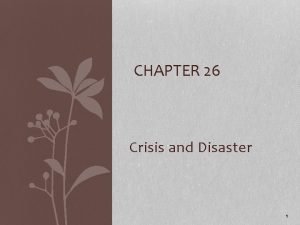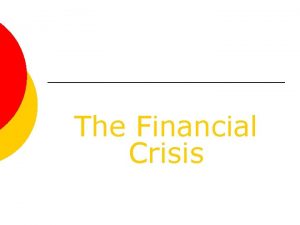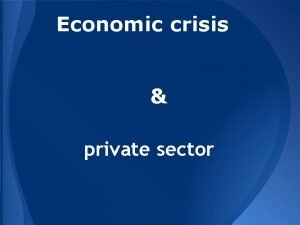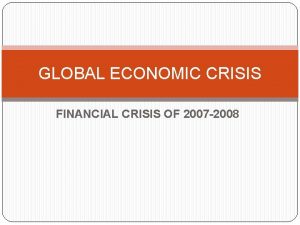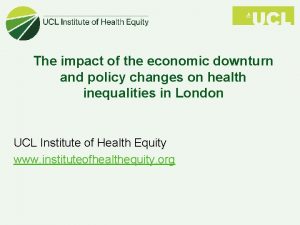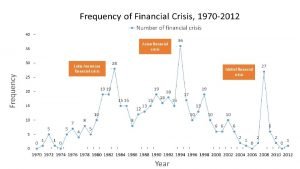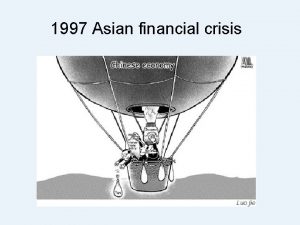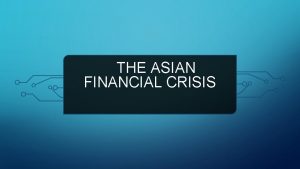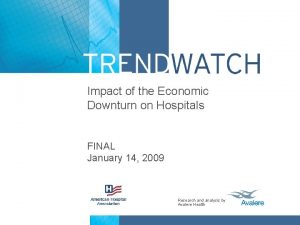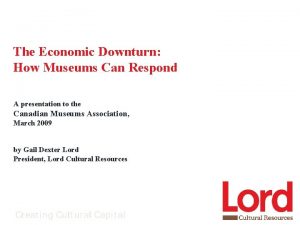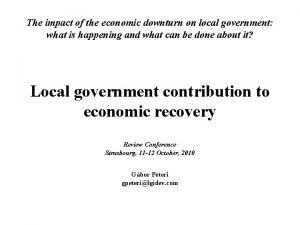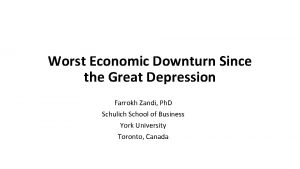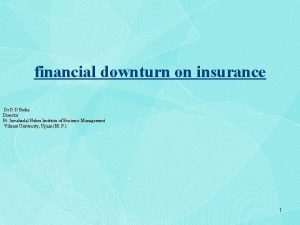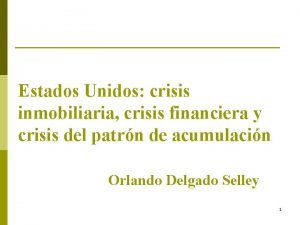Financial crisis and economic downturn Where did they



















































- Slides: 51

Financial crisis and economic downturn: Where did they come from and where are they going? Presentation by Charles (Chuck) Freedman Scholar in Residence, Economics Department, and co-director, Centre for Monetary and Financial Economics, Carleton University Halifax Initiative Conference, October 15, 2009

Introductory remarks • Many elements in explanation of the current financial and economic crisis • Complex interactions among the various elements • Most notably, the financial crisis and the economic downturn fed on each other, with the deterioration in the financial sector worsening economic situation and deterioration in the economy intensifying financial crisis

Subprime mortgage markets • Begin with problems in US subprime mortgage markets • Many weaknesses and lots of blame to go around • First, perhaps in part as a result of the originate to distribute model, decline in lending standards and monitoring of mortgages • Second, financial institutions should have been much more aware that housing prices typically do not rise forever

Subprime mortgage markets • Third, some of the practices of originators and brokers worsened outcomes (a) encouraged borrowers into variable rate mortgages (b) initial “teaser” interest rates (c) compensation of agents arranging such mortgages • Fourth, in the United States, view of governments and governmental authorities that homeownership should be encouraged and subsidized • Fifth, legal situation of no recourse in most states in the United States

Derivatives • Risk with derivatives that “the inherent complexity of the instruments raises the concern that management will not understand or be able to control effectively the amount or type of risk being taken on by the firm”. • In many cases, either companies did not understand the underlying risks that they were taking and/or underestimated probability of tail events

Derivatives • For many years, mortgage-backed securities operated very effectively • Then came collateralized debt obligations (CDOs) with tranches that could be tailored to the needs and desires of purchasers • Credit rating agencies played important role in providing ratings to the various tranches of these instruments • But neither rating agencies nor purchasers of these instruments had a very clear understanding of the probabilities with respect to the outcomes of the payment flows from these instruments

Derivatives • Purchasers rarely did due diligence themselves, relying excessively on the CRAs • Among the problems that the CRAs had difficulty in addressing were – default probabilities (in absence of long history with subprime mortgages); sensitivity to small errors in estimation of riskiness of tranches of CDOs and especially CDO-squared; underestimate of correlations of returns on assets backing the CDOs • And some concerns have been expressed about the CRAs’ conflicts of interest

Derivatives • Credit default swaps (CDSs) also played important role in the development of the financial crisis • In many cases, sellers of CDSs underestimated the probability of unlikely negative outcomes (“tail events”) occurring • And purchasers frequently underestimated or ignored the risk that the counterparty (e. g. , AIG, monoline insurers) would be unable to pay off the insurance if the insured event occurred

Derivatives • A fundamental problem in this and other areas was the failure of risk management • Either risk management units did not recognize the extent of risk involved in the strategy being followed or senior management did not pay sufficient attention to the concerns of risk management units • Problems with compensation arrangements that took insufficient account of what might happen in coming years

Regulation/supervision • Either authorities did not recognize the risks being undertaken or pressures from governments to provide light regulation outweighed any concerns they might have had • Some financial entities that did not appear to fall under safety net less supervised than those that did fall under the safety net • In practice, it turned out that a number of such entities were either too large to fail or too complex to fail or too interconnected to fail and therefore in the end did fall under a form of safety net provided by the authorities

Assumptions about liquidity • Another problem was the assumption that there would always be liquidity in the markets for the financial instruments and therefore arrangements for dealing with potential liquidity problems insufficiently robust • Indeed, the business case of some financial institutions based on the assumption that they would always be able to access wholesale markets for funding

The unfolding of the financial crisis • Housing prices started to fall and default rates began to rise sharply in mortgage markets, particularly subprime • With little past experience, great uncertainty as to value of mortgages and even more so as to the value of complex derivatives based on such mortgages • Markets began to dry up, with investors unwilling to purchase instruments whose value was so uncertain • Lack of transparency also meant no-one was sure who was holding the “bad assets”

The unfolding of the financial crisis • Liquidity of interbank lending markets in turn began to dry up -- increasing desire to hold liquid assets and concerns about counterparties’ solvency because of increased uncertainty about the value of assets held by financial institutions in general • Spreads between interest rates faced by “risky” borrowers and those faced by “riskless” borrowers began to increase, at times sharply (have declined in more recent period and are currently back to normal)


The unfolding of the financial crisis • Also, concern about quality of household and business loans on balance sheets of financial institutions • Decline of capital as losses spread • Absence of markets for certain kinds of assets and uncertainty regarding the quality of those assets made it very difficult to gauge whether liquidity or solvency problem

Macroeconomic developments and interaction with financial crisis • Before the onset of the crisis in 2007, the global economy had a long period of fairly steady growth • Low inflation • Globalization • Nonetheless, concerns about the “quality” of the economic expansion • Large imbalances in the world economy • Concerns about the increase in the ratio of household debt to personal disposable income



Macroeconomic developments and interaction with financial crisis • Persistence of low real interest rates in the context of stable growth and low inflation led to a willingness to take on more risk as part of a search for yield • The resulting asset price bubble in turn underpinned the economic expansion on the part of both households and businesses • Turnaround in house prices and the onset of the financial crisis began to change the economic situation

Macroeconomic developments and interaction with financial crisis • Over time, the real-financial linkages interacted in a way that caused deterioration in both the financial sector and the real economy • Problems in the financial sector led to weaknesses in spending while weaknesses in spending led to further problems in the financial sector • Concern of authorities was to prevent downward spiral and to break these linkages

Reaction of the authorities • Authorities faced multiple challenges – liquidity problems; solvency problems; rapidly weakening macro situation; and, in longer run, how to restructure/reregulate the financial system to avoid future such crises • Principal objective of authorities was initially to avoid a meltdown or implosion of the financial sector, as this was seen to be one of the major factors in bringing about the Great Depression of the 1930 s (Bernanke) and subsequently to provide support to the macro economy

Reaction of authorities to financial crisis -- liquidity • Initial issue desire by banks for increased liquidity • Central banks carried out traditional lender of last resort function by supplying the increased liquidity desired by banks • Over time, this part of central banks’ support function broadened in a number of ways • First, term loans • Second, loans to non-traditional institutions • Third, purchase of riskier assets • Fourth, higher risk collateral • Fifth, foreign exchange swap arrangements • Sixth, securities lending facilities


Reaction of authorities to financial crisis -- solvency • Focused on financial entities believed to be either “too big to fail” or “too complex to fail” or “too interconnected to fail”, i. e. , the institutions that were believed to pose risks to the entire system (systemically important financial institutions) • Governments bailed out a number of institutions

Reaction of authorities to financial crisis -- solvency • Four principal approaches were taken – assisted mergers, injections of equity capital or preferred shares, purchase or guarantee of “toxic assets”, guarantee of liabilities • While each of these had the effect of preventing losses to depositors, their implications for non-deposit creditors and shareholders differed

Reaction of authorities to financial crisis -- solvency • There is not very much literature on the advantages and disadvantages of these various techniques, and governments have been using “seat-of-the-pants” approach to decision-making in this area • Need more study as to which approaches are best in different circumstances

Reaction of authorities to financial crisis • Other issues have arisen in context of liquidity and solvency problems • Proper coordination among the various authorities responsible for financial stability • Division of responsibility for financial stability in the euro area (ECB versus national central banks) • Countries in which banks have grown very large relative to the size of the economy (Iceland, Ireland) • Role of international organizations

Reaction of authorities to macroeconomic downturn • Principal concern to avoid self-reinforcing downward spiral that would turn fairly sharp downturn into much deeper and more prolonged contraction, possibly including deflationary pressures that could intensify the downturn • Both monetary and fiscal tools were used • Moreover, once policy interest rates approached zero lower bound, central banks began to consider unconventional measures

Monetary easing • Unconventional monetary easing means different things to different people • Recent practice has been to distinguish between quantitative easing and credit easing or qualitative easing • One set of definitions is as follows (Buiter) • Quantitative easing is an increase in the size of the balance sheet of the central bank through an increase in its monetary liabilities (base money), holding constant the composition of its assets • Credit or qualitative easing is a shift in the composition of the assets of the central bank towards less liquid and riskier assets, holding constant the size of the balance sheet and the official policy rate

Quantitative easing • In my view, quantitative easing so defined will have relatively little effect on the economy • In circumstances where many assets already yielding zero return and in which loans seem very risky, the banks may be perfectly happy to simply hold excess reserves • Example from Japan from the 1990 s – high base growth, moderate money growth, negative loan growth • Of course, part of the problem in Japan was the continued weakness of financial sector


Qualitative easing • Qualitative easing has the potential of having considerable effect • It could work through reductions of risk premiums of various sorts and perhaps through its effect on expectations • Also, could improve functioning of markets that were in difficulty


Fiscal policy • In face of continued weakness of global economy, focus of macro policy turned to fiscal policy • Questions with respect to the effectiveness of temporary fiscal stimulus and with respect to the preferred mix of policy • Research at the IMF in which I was involved concluded that certain types of global fiscal measures along with accommodative monetary policy can make an important contribution to underpinning the global economy 34

Fiscal policy • Fiscal policy has taken important role, especially during the period in which monetary policy constrained by the zero lower bound (even with quantitative and credit easing) and in which financial sector not able or willing to extend credit to the normal extent • Important that fiscal stimulus is global and that monetary policy is accommodative 35

Fiscal policy • But danger if stimulus packages being considered create a perception of lack of fiscal discipline, and more so if lack of fiscal discipline is not just perceived but also realized • Credibility concern could be addressed through appropriate and credible medium-term fiscal frameworks such as the introduction of fiscal rules (e. g. , long-run targets for ratio of fiscal deficit or fiscal debt to GDP) • Also important to avoid protectionist elements in fiscal packages 36

Exit strategy -- macro • Aggressive monetary and fiscal strategies along with support for the financial sector have prevented even worse outcomes • Appears that the recovery has started (“green shoots”) but still hesitant in industrialized economies • Also, because of the ongoing weakness of the financial sector and some continued underlying macro problems, likely to be a more gradual recovery than is typical at this stage of the cycle • In many of the emerging economies, downturn was much less severe and recovery has been more robust

Exit strategy -- macro • Importance of reversal of both monetary and fiscal easing as economies come out of recession and settle into stronger phase of the recovery • On the monetary policy side, the very high level of stimulus that is currently in place will have to be removed • And at least some of the special initiatives introduced by central banks in the form of credit easing and to deal with liquidity problems will likely be withdrawn • However, consideration may well be given to retaining some of these initiatives as part of the restructuring of the financial system

Monetary stability and financial stability • The interrelationship of monetary stability and financial stability and the possible role of financial stability issues in the conduct of monetary policy will undoubtedly receive considerable attention • Should monetary policy respond to asset price bubbles? “Lean or clean? ” • Or, as I would argue, should instruments other than interest rates be the main mechanism in avoiding excessive credit growth and asset price booms? • In case of the latter, how do they affect transmission mechanism for monetary policy?

Exit strategy -- macro • On the fiscal side, it will be essential to return to a credible track for the debt to GDP ratio • In the absence of such measures, we can expect to see higher long-term real interest rates (and hence lower growth of potential output) than otherwise • Consideration should be given to the introduction of fiscal rules as a way of facilitating appropriate budgetary behavior

Exit strategy -- macro • Of course, the main challenge to both monetary and fiscal policy is to get the timing “right” • Premature tightening could slow down an incipient recovery • Excessive delays in tightening could eventually result in inflationary pressures developing • As is always the case, the monetary and fiscal authorities will have to rely upon forecasts, but in the current circumstances of both financial and macro uncertainties, forecasting is especially difficult

Financial sector restructuring and regulation • Governments will have to find ways to exit from bail-outs of financial sector (capital injections, guarantees, and holdings of toxic assets) • Much attention is being paid and will continue to be paid to changes in regulation and supervision of the financial sector • But will want to avoid regulation that will stifle useful innovation • G 20 work plan grouped reform efforts under three headings – improving domestic regulation; cross-border regulation and cooperation; and IFI reform and refinancing • My own listing of possible reform efforts is as follows

Financial sector restructuring and regulation CAPITAL AND LIQUIDITY • (1) Higher capital and better quality capital • (2) Unweighted leverage ratios • (3) Countercyclical leverage of some sort • (4) Consolidation of off-balance-sheet entities • (5) Possible limitations on proprietary trading • (6) Liquidity requirements of some form

Financial sector restructuring and regulation MARKET PRACTICES AND ARRANGEMENTS • (7) Increased use of strongly risk-proofed clearing and settlement systems with central counterparties for clearing and settlement of derivative transactions of various kinds • (8) Possible reorganization of the originate to distribute model to ensure that originators have incentive to monitor underlying loans • (9) Role of credit rating agencies

Financial sector restructuring and regulation COMPENSATION ARRANGEMENTS • (10) Attention to incentives at all levels of organizations in the financial sector – may lead to compensation arrangements with increased focus on the medium term and even longer term • Whether this will be done by boards themselves or with government involvement remains to be seen • Boards will likely come under pressure by shareholders in setting of compensation

Financial sector restructuring and regulation SUPERVISORY ARRANGEMENTS • (11) If entities previously unregulated turn out to be too large to fail or too complex to fail or too interconnected to fail and likely to fall under safety net if run into serious difficulties , essential to bring them under some form of regulation. • (12) Attention to financial sector that is large relative to size of the country • (13) Much more attention to the role and influence of risk management units • (14) Increased regulation of mortgage markets • (15) Greater transparency (reduced opacity), particularly in the case of derivatives

Financial sector restructuring and regulation • (16) More and higher quality (better paid) supervisory staff • (17) Legislation should not be overly rigid yet should provide sufficient safety and stability to avoid repeat of financial crisis • (18) Possible reorganization of entities responsible for supervision • (19) In some countries, need for better mechanisms for closure of financial institutions and for crisis resolution • (20) Possible reconsideration of mark to market accounting, but not necessarily elimination

Financial sector restructuring and regulation MACRO PRUDENTIAL • (21) Macro prudential supervision will receive greater attention. Central banks likely to play a leading role in this area. • (22) Relatedly, the concept of systemically important financial institutions will play a greater role in regulatory and supervisory arrangements

Financial sector restructuring and regulation SUPERVISORY COORDINATION DOMESTICALLY AND INTERNATIONALLY • (23) Need for better coordination across the authorities in a given country and across countries • (24) In terms of cross-border regulatory arrangements, there will undoubtedly be much discussion of how to deal with financial institutions with a worldwide footprint

Future macro and financial sector policies • More generally, focus on implications of the policy decisions on incentives and potential behavior of financial institutions and financial market participants, as well as the authorities • Essential to address moral hazard concerns • Roles and inter-relationships of G 20, IFIs (especially IMF), standard setting bodies (such as Basle Committee), domestic authorities (e. g. , peer review) will have to be worked out

Concluding remarks • Financial sectors and economies worldwide have been under enormous stress in the last couple of years • Unprecedented actions by the authorities appear to have prevented the situation from becoming even worse than it has been • Looking forward, important decisions will have to be made regarding what is needed to restructure the financial system to avoid a recurrence of the problems that it has faced and whether some of the innovative techniques introduced by the authorities to combat the crisis should be retained for the longer term
 Myasthenic crisis vs cholinergic crisis
Myasthenic crisis vs cholinergic crisis Because you have rejected me i have rejected you
Because you have rejected me i have rejected you Knowledge not shared is wasted
Knowledge not shared is wasted Iceland economic crisis
Iceland economic crisis What is economic growth and development
What is economic growth and development Comesa monetary institute
Comesa monetary institute Asian financial crisis
Asian financial crisis Showa financial crisis
Showa financial crisis Economic growth vs economic development
Economic growth vs economic development Lesson 2 our economic choices
Lesson 2 our economic choices Rankings: what are they and do they matter?
Rankings: what are they and do they matter? Financial methods of motivation definition
Financial methods of motivation definition What vikings drank
What vikings drank What race were the anglo saxons
What race were the anglo saxons What did you do yesterday? i _____. *
What did you do yesterday? i _____. * How did you … your last weekend?
How did you … your last weekend? If we meet him tomorrow we will say hello
If we meet him tomorrow we will say hello They seek him here they seek him there
They seek him here they seek him there They are they which testify of me
They are they which testify of me Grammar rules frustrate me they're not logical they are so
Grammar rules frustrate me they're not logical they are so For they not know what they do
For they not know what they do The modern colossus of railroads political cartoon meaning
The modern colossus of railroads political cartoon meaning What economic problems did germany face after ww1
What economic problems did germany face after ww1 Farewell to manzanar chapter 22 questions and answers
Farewell to manzanar chapter 22 questions and answers A : were you at the beach last weekend? b : no, i
A : were you at the beach last weekend? b : no, i Yesterday we (play)football after class
Yesterday we (play)football after class How did the vikings know where they were going
How did the vikings know where they were going Ancient greek actors wore
Ancient greek actors wore Herbivores dinosaur
Herbivores dinosaur They flee from me summary
They flee from me summary What did they eat on ve day
What did they eat on ve day How was your last weekend
How was your last weekend What did you do in london last weekend
What did you do in london last weekend Where did they go last weekend
Where did they go last weekend Microsoft virtual academy
Microsoft virtual academy Fuiyou
Fuiyou Moos and schaefer 1984 crisis theory
Moos and schaefer 1984 crisis theory Crisis management team composition
Crisis management team composition Ford and firestone crisis management
Ford and firestone crisis management Exclusion crisis in absalom and achitophel
Exclusion crisis in absalom and achitophel Chapter 26 crisis and disaster
Chapter 26 crisis and disaster Crisis and absolutism in europe
Crisis and absolutism in europe George washington crisis management
George washington crisis management Alternate rebellion dbt
Alternate rebellion dbt School crisis prevention and intervention
School crisis prevention and intervention Crisis and emergency risk communication
Crisis and emergency risk communication Hybrid model of crisis intervention
Hybrid model of crisis intervention Mit crisis management and business continuity
Mit crisis management and business continuity Wrap crisis plan examples
Wrap crisis plan examples Icews
Icews Crisis communications working group
Crisis communications working group Manejo de la urgencia hipertensiva
Manejo de la urgencia hipertensiva



